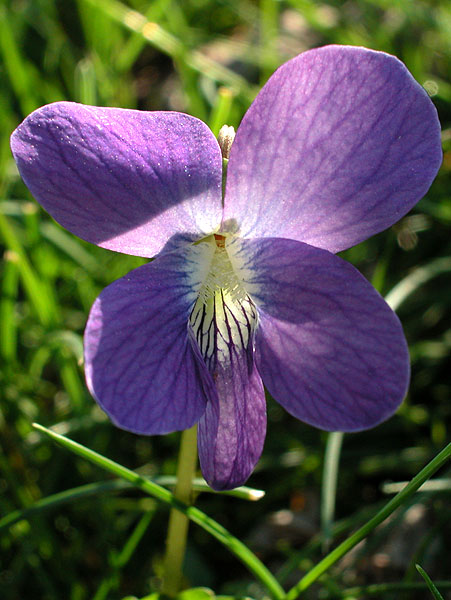“Forgiveness is the fragrance that the violet sheds on the heel that has crushed it.” -- Mark Twain
Adaptation
 Not
so teeny and simple after all?
Not
so teeny and simple after all?
The Common Blue Violet seems to be a simple flower that
individuals of all ages can identify. However,
for the few who take the time to closely examine this
species, they discover the commonly missed details and features that
are often overlooked. Because the Common Blue Violet is so small, it
has adapted many characteristics to aid in its development.
This species has developed colored petals
(often blue or violet) and a scent to attract pollinating insects.
The blossom has five petals: two upper, two lateral, and one bottom.
The upper and lateral pairs act as flags to attract
pollinating insects, while the bottom petal serves as a landing
strip. These insects are directly guided into to the
nectar-containing spur of the flower at the rear of the bottom petal by linear
markings called honey guides, which are more visible to the ultraviolet-sensing eyes of bees than to the human eyes. To us they are just decorations, but
to the Common Blue Violet, these veins of color play a huge role in
reproduction. Near the nectar opening are tiny hairs, seen
in the picture on the right. This
adaptation allows the insect to grab onto something as it pushes
its head inside for nectar, but mainly serves the purpose of preventing rain or
dew drops from getting in and diluting the nectar, similar to our
eyelashes.
ultraviolet-sensing eyes of bees than to the human eyes. To us they are just decorations, but
to the Common Blue Violet, these veins of color play a huge role in
reproduction. Near the nectar opening are tiny hairs, seen
in the picture on the right. This
adaptation allows the insect to grab onto something as it pushes
its head inside for nectar, but mainly serves the purpose of preventing rain or
dew drops from getting in and diluting the nectar, similar to our
eyelashes.
 The development of
cleistogamous flowers is another adaptation that enhances the
reproduction of Viola sororia. These flowers may
appear lower on the plant, under the ground, and often later in the
season. They are viewed as
self-pollinating buds, pods, or defective flowers that never
open or bloom, but contain all the necessary parts to produce
fertile seeds. Most flowers of the Common Blue Violet will bloom in
early spring when
insect pollination does not occur often. In order to make up for
this, the species developed cleistogamous flowers that bloom later in the season, since these are
self-pollinating.
The development of
cleistogamous flowers is another adaptation that enhances the
reproduction of Viola sororia. These flowers may
appear lower on the plant, under the ground, and often later in the
season. They are viewed as
self-pollinating buds, pods, or defective flowers that never
open or bloom, but contain all the necessary parts to produce
fertile seeds. Most flowers of the Common Blue Violet will bloom in
early spring when
insect pollination does not occur often. In order to make up for
this, the species developed cleistogamous flowers that bloom later in the season, since these are
self-pollinating.
This plant provides food for other organisms, but you might wonder how it gets its own food. Check out the Nutrition page next!